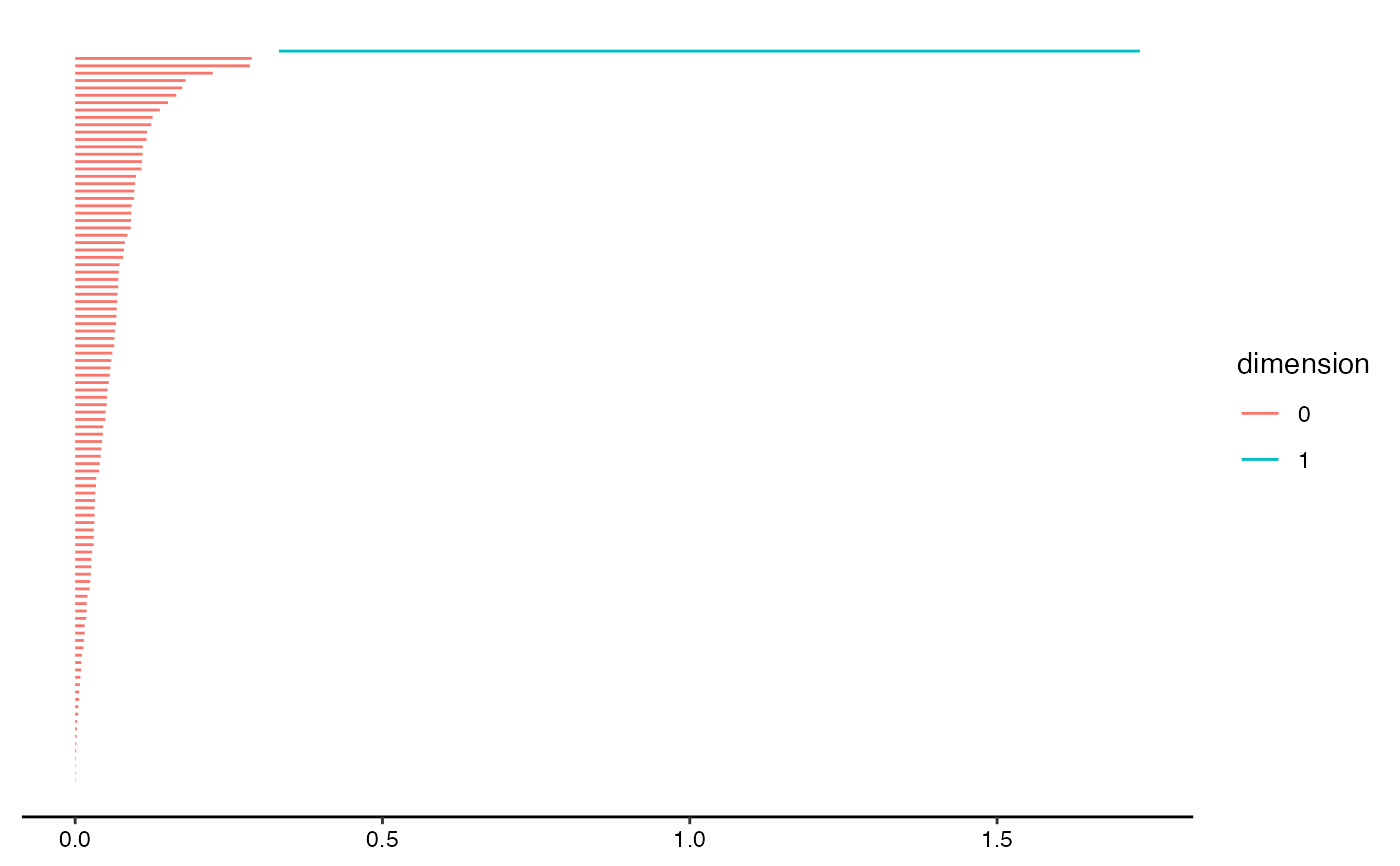Visualize persistence data in a barcode diagram.
geom_barcode(
mapping = NULL,
data = NULL,
stat = "persistence",
position = "identity",
na.rm = FALSE,
show.legend = NA,
inherit.aes = TRUE,
...
)Arguments
- mapping
Set of aesthetic mappings created by
aes(). If specified andinherit.aes = TRUE(the default), it is combined with the default mapping at the top level of the plot. You must supplymappingif there is no plot mapping.- data
The data to be displayed in this layer. There are three options:
If
NULL, the default, the data is inherited from the plot data as specified in the call toggplot().A
data.frame, or other object, will override the plot data. All objects will be fortified to produce a data frame. Seefortify()for which variables will be created.A
functionwill be called with a single argument, the plot data. The return value must be adata.frame, and will be used as the layer data. Afunctioncan be created from aformula(e.g.~ head(.x, 10)).- stat
The The statistical transformation to use on the data. Defaults to
identity; pass a string to override the default.- position
Position adjustment, either as a string naming the adjustment (e.g.
"jitter"to useposition_jitter), or the result of a call to a position adjustment function. Use the latter if you need to change the settings of the adjustment.- na.rm
Logical: if
FALSE, the default,NAlodes are not included; ifTRUE,NAlodes constitute a separate category, plotted in grey (regardless of the color scheme).- show.legend
logical. Should this layer be included in the legends?
NA, the default, includes if any aesthetics are mapped.FALSEnever includes, andTRUEalways includes. It can also be a named logical vector to finely select the aesthetics to display.- inherit.aes
If
FALSE, overrides the default aesthetics, rather than combining with them. This is most useful for helper functions that define both data and aesthetics and shouldn't inherit behaviour from the default plot specification, e.g.borders().- ...
Additional arguments passed to
ggplot2::layer().
Details
Barcodes or barcode diagrams are vertical interval plots of persistence data.
Persistence data
Persistence data encode the values of an underlying parameter \(\epsilon\) at which topological features appear ("birth") and disappear ("death"). The difference between the birth and the death of a feature is called its persistence. Whereas topological features may be of different dimensions, persistence data sets usually also include the dimension of each feature.
ggtda expects persistence data to have at least three columns: birth, death, and dimension.
Barcodes
Barcodes traditionally extend along the horizontal axis and are arranged vertically in order of group (e.g. dimension) and birth. They may also be transposed and juxtaposed with persistence diagrams. While topological features of different dimensions are usually plotted together in persistence diagrams, barcodes often separate segments corresponding to features of different dimension, by vertical grouping or by faceting.
Aesthetics
geom_barcode() understands the following aesthetics (required aesthetics are in bold):
startendalphacolourgrouplinetypelinewidth
Learn more about setting these aesthetics in vignette("ggplot2-specs", package = "ggplot2").
References
G Carlsson, A Zomorodian, A Collins, and L Guibas (2004) Persistence barcodes for shapes. Proceedings of the 2004 Eurographics/ACM SIGGRAPH symposium on Geometry processing, 124--135. doi:10.1145/1057432.1057449
G Carlsson (2014) Topological pattern recognition for point cloud data. Acta Numerica 23, 289--368. doi:10.1017/S0962492914000051
F Chazal and B Michel (2017) An introduction to Topological Data Analysis: fundamental and practical aspects for data scientists. https://arxiv.org/abs/1710.04019
See also
ggplot2::layer() for additional arguments.
Other plot layers for persistence data:
landscape,
persistence
Examples
# toy example
toy.data <- data.frame(
appear = c(0, 0, 0, 1, 2),
disappear = c(5, 3, 3, 5, 3),
dim = c("0", "0", "0", "2", "1")
)
# topological barcode using the geom layer (and minimalist theme)
ggplot(toy.data,
aes(start = appear, end = disappear, colour = dim, shape = dim)) +
geom_barcode() +
theme_barcode()
 # load library and dataset for comprehensive example
library("ripserr")
angles <- runif(100, 0, 2 * pi)
circle2d <- cbind(cos(angles), sin(angles)) # unit circle (Betti-1 number = 1)
# calculate persistence homology and format
circ.phom <- as.data.frame(vietoris_rips(circle2d))
circ.phom$dimension <- as.factor(circ.phom$dimension)
# pretty topological barcode with geom layer
ggplot(circ.phom, aes(start = birth, end = death,
colour = dimension)) +
geom_barcode() +
theme_barcode()
# load library and dataset for comprehensive example
library("ripserr")
angles <- runif(100, 0, 2 * pi)
circle2d <- cbind(cos(angles), sin(angles)) # unit circle (Betti-1 number = 1)
# calculate persistence homology and format
circ.phom <- as.data.frame(vietoris_rips(circle2d))
circ.phom$dimension <- as.factor(circ.phom$dimension)
# pretty topological barcode with geom layer
ggplot(circ.phom, aes(start = birth, end = death,
colour = dimension)) +
geom_barcode() +
theme_barcode()
